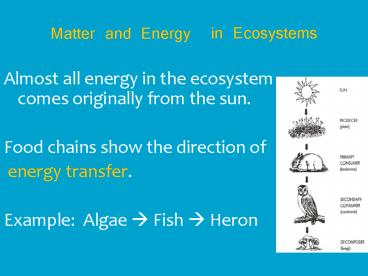Matter and Energy in Ecosystems - PowerPoint PPT Presentation
1 / 16
Title:
Matter and Energy in Ecosystems
Description:
Matter and Energy in Ecosystems Almost all energy in the ecosystem comes originally from the sun. Food chains show the direction of energy transfer. – PowerPoint PPT presentation
Number of Views:118
Avg rating:3.0/5.0
Title: Matter and Energy in Ecosystems
1
Matter and Energy in Ecosystems
- Almost all energy in the ecosystem comes
originally from the sun. - Food chains show the direction of
- energy transfer.
- Example Algae ? Fish ? Heron
2
Drawing a Food Chain
Food chains represent the flow of energy as
one organism is consumed by another. The
arrow should be drawn from the organism being
consumed to the consumer.
3
(No Transcript)
4
- Trophic level
- a step in the food chain.
- What type of organism is always at the 1st
trophic level? - autotroph/producer
- What type(s) of organism can be at the 2nd
trophic level? - herbivore or omnivore
5
Ecological Pyramid
- When you compare the biomass (mass of living
things) at each level of a food chain, it forms a
pyramid. - The greatest mass is always the autotrophs
(producers) with decreasing amounts at higher
trophic levels.
6
- The Law of Conservation of Energy states that
matter can not be created or destroyed. Yet the
energy pyramid shows that less energy is
available as you move up a food chain. What
happens to the rest of the energy?
Much of the energy that an organism consumes is
given off in the form of heat.
7
(No Transcript)
8
- Implications of the Energy Pyramid
- It takes approximately 16 x more energy to
produce a pound of beef as it does to produce a
pound of soybeans, since much of the energy
consumed by the cow is transformed to heat.
9
Bioaccumulation and Biomagnification
- Bioaccumulation a toxin that remains in body
tissue. - Toxins that bioaccumulate include PCBs, DDT and
mercury. - Biomagnification an increase in the
concentration of a substance in organisms higher
up the food chain. - This occurs because each step in the food chain
must consume a greater amount of the previous
level.
10
Concentration of a toxin increases up a food
chain.
11
- King mackerel is a fish that tends to be high
in mercury, tilapia is a fish that is usually low
in mercury contamination. Predict what that
indicates about their roles in the food chain. - Fish that are high in mercury contamination
tend to be fish at the top of the food chain
(king mackerel, shark).
12
(No Transcript)
13
Food Webs
- Many heterotrophs feed on more than one type of
organism. - So most communities have energy flow in a food
web, made of interacting food chains.
14
Population Growth Patterns
- Under ideal conditions, the reproductive rates of
species allows for exponential growth. - Exponential growth is growth in which the rate
of change is proportional to the amount (and
therefore increases by an increasing amount,
forming a J-shaped curve).
15
Population Growth Patterns
- Most populations must compete for limited
resources and their growth levels off after a
period of exponential growth. - This pattern forms an S-shaped graph and is
called logistic growth.
16
Carrying Capacity
- Carrying capacity is the maximum number of a
species that a particular environment can
normally support.































